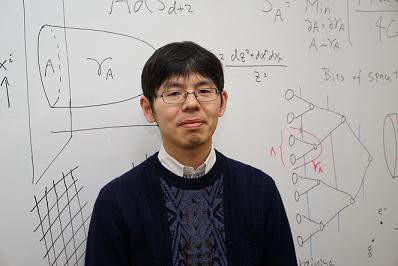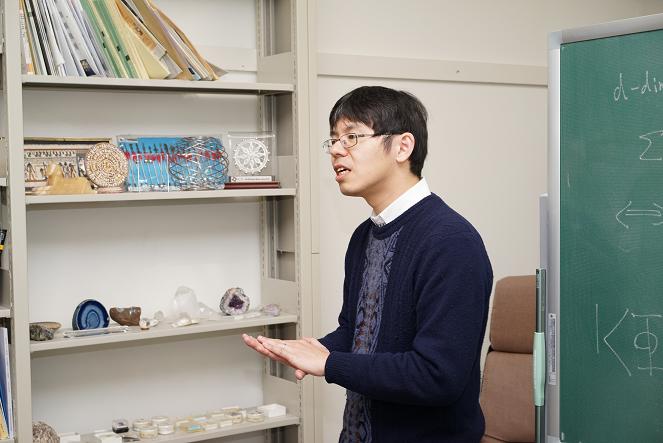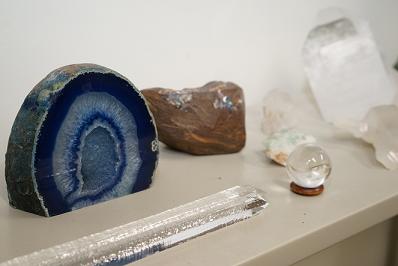String theory in the spotlight

An interview with
Tadashi Takayanagi
Professor
Yukawa Institute for Theoretical Physics
On being awarded the 2015 New Horizons in Physics Prize
Professor Tadashi Takayanagi of the Yukawa Institute for Theoretical Physics, Kyoto University, has been awarded The 2015 New Horizons in Physics Prize for his work on "fundamental ideas about entropy in quantum field theory and quantum gravity".
The New Horizons in Physics Prize is part of The Breakthrough Prizes, which were created by venture capitalist Yuri Milner, Facebook founder Mark Zuckerberg, Google co-founder Sergey Brin, and others in 2012. The prizes celebrate outstanding research in the categories of fundamental physics, life sciences, and mathematics.
Prof Takayanagi at his office at the Yukawa Institute of Theoretical Physics, Kyoto University
Professor Takayanagi shares the prize with Shinsei Ryu of the University of Illinois at Urbana-Champaign, and with Horacio Casini and Marina Huerta of The National Scientific and Technical Research Council (CONICET) and Instituto Balseiro, Universidad Nacional de Cuyo, Argentina.
First of all, congratulations on your being awarded The 2015 New Horizons in Physics Prize. Could you please share your thoughts on receiving this award?
Takayanagi: Thank you very much. It is a great honor to be awarded this renowned prize. Especially this is so encouraging to me in that my research accomplishments were well recognized internationally. The prize started two years ago by Yuri Milner, who is a famous entrepreneur and venture capitalist related to IT business, and others in order to award young researchers who made important contributions to fundamental physics.
Could you tell us a little more about your research into quantum field theory and what led up to the prize?
Takayanagi: My research area is called string theory and is one important subject of high energy physics theory. The traditional question asked in high energy physics as the main problem is: "What will remain finally if we try to decompose repeatedly any materials around us such as desks, books, coins, etc into smaller materials?" The answer is elementary particles and basic examples of them are electrons, quarks and photons. We now have an almost satisfactory theory, called standard model, using the theoretic formulation of quantum field theory — and this nicely explains the behaviors of elementary particles — which has been confirmed by many particle physics experiments so far.

Prof Takayanagi's depiction of entanglement entropy
Then, the next important question will be: "What is the minimum unit of our spacetime or universe?" This is a much more difficult and profound question but is extremely important in order to investigate the origin and the fundamental structure of our universe. My main purpose of research is to answer precisely this question. Einstein's theory of general relativity already tells us that to understand our universe, we need to study the theory of gravity. Therefore we need to develop general relativity so that we can explore a microscopic physics of gravity, which is called quantum gravity. The most promising candidate of quantum gravity is called string theory and this is the reason why I am studying string theory in most of my researches.
My main research achievement, which has been recognized by the recent prize, provides a surprising prediction on the minimum unit of our universe. One of the most remarkably new properties of microscopic theories (quantum theories) is quantum entanglement. This phenomenon leads to an ambiguity of information or equally some hidden information. What I discovered is that everywhere in our universe, there always exists some hidden information. In other words, this implies that the minimum unit of the universe is one bit of "hidden information". In information theory, we measure the amount of such information by using the quantity "entropy". The result shows that any spacetime with gravity has its own entropy. In this way, my discovery opens up a new research direction to understand properties of quantum gravity by using information theory. Indeed, many string theory researchers all over the world are now actively working on this new topic.
Thank you very much for the clear and incisive description of your work. I understand that you have served Postdoctoral Fellowships at both the Kavli Institute for Theoretical Physics, University of California, Santa Barbara, and the Jefferson Physical Laboratory, Harvard University. Could you please share some of your experiences during this time?
Takayanagi: Just after I got my PhD at Tokyo University, I moved to Harvard University as a postdoctoral fellow. At first I was shocked because research styles were pretty different from those in Japan. For example, any researchers from students to professors enjoyed discussions with anyone so frequently and frankly. It seemed that they spent most of the time for discussions during their office time. Also, research interests and motivations were rather different between Japan and the US, though we were working on the same subject.
Indeed this stimulating environment largely helped me to choose my main research topic, which I have pursued until now. After three years at Harvard, I moved to the Kavli Institute for Theoretical Physics, UC Santa Barbara, for another postdoctoral fellowship. The nice structure of the building and the policy of this institute encourage researchers working on different subjects to interact frequently. Owing to this interdisciplinary atmosphere, I had an opportunity to collaborate with a condensed matter physicist (Prof Shinsei Ryu, who is an assistant professor at the University of Illinois at Urbana–Champaign) and this collaboration led to the work which was awarded the prize.
And what brought you to Kyoto? What are the advantages of conducting your work at the Yukawa Institute for Theoretical Physics?
Takayanagi: First of all, I like the academic atmosphere of Kyoto University, which originated from the policy of academic freedom. This encourages researchers to consider any problem which each of them thinks is the most important very deeply and very carefully. Moreover, the Yukawa Institute for Theoretical Physics provides us with a wonderful environment for such researchers. At this institute, there are many world-class physicists who are actively working on different subjects in theoretical physics in a very interdisciplinary atmosphere, as at the Kavli Institute, UC Santa Barbara.
One of Prof Takayanagi's hobbies is mineral collecting; here he holds a crystal quartz from Brazil
Here in your office at the Yukawa Institute for Theoretical Physics, you have a really impressive rock collection. Could you tell us more about it?
Takayanagi: I started "stone hunting" as a hobby when I was an undergraduate student. Especially I loved the hunting of minerals with beautiful crystals. I used to visit old mines and quarries etc for this purpose with my friends at that time. Recently even though I am too busy to go on such a trip, I like to visit mineral museums and shops. So my collections are still slowly growing. I have really appreciated the beautiful symmetries of natural crystals, which might have led me to the study of theoretical physics.
Prof Takayanagi's collection of crystals and minerals
Finally, what would be your advice to early-career researchers interested in pursuing string theory?
Takayanagi: Nowadays string theory is intimately connected to many other subjects of physics such as condensed matter physics and quantum information theory, as well as to various subjects of mathematics. This means that still nobody knows "what is the true ability of string theory?" or even "what is string theory?" even at present. It may be possible that unexpected connections to other (seemingly unrelated) subjects can produce remarkable successes. So I would like to suggest younger string theory researchers to have broad interests in various topics and to develop deep insights in theoretical physics.
Published: 3 December 2014
Profile

Professor Tadashi Takayanagi obtained his bachelor's, master's, and doctoral degrees in Physics from the University of Tokyo in 1998, 2000, and 2002 respectively. Prior to his appointment as Professor at the Yukawa Institute for Theoretical Physics, Kyoto University, in 2012, he served Postdoctoral Fellowships at the Jefferson Physical Laboratory, Harvard University (2002–2005), and the Kavli Institute for Theoretical Physics, University of California, Santa Barbara (2005–2006). He is also a Visiting Senior Scientist at the Kavli Institute for the Physics and Mathematics of the Universe (Kavli IPMU). Prof Takayanagi has received awards including the 4th Yukawa-Kimura Prize (January 2011), the 28th Nishinomiya-Yukawa Memorial Prize (November 2013), and The 2015 New Horizons in Physics Prize (November 2014).
Additional information
To discover more about Prof Takayanagi's work, click here
For more information about The Breakthrough Prizes, click here
Kyoto University Research Administration Office (KURA)




